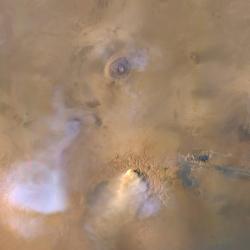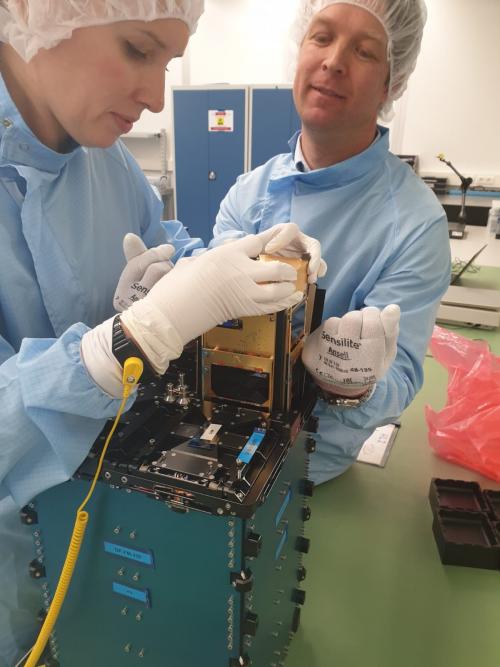Today, on the 3rd of September, two Belgian CubeSats, PICASSO (from the Royal Belgian Institute for Space Aeronomy) and SIMBA (from the Royal Meteorological Institute) were launched simultaneously with about 50 tiny satellites, on board Europe’s inaugural Vega SSMS flight. They will - hopefully - demonstrate that CubeSats have reached the necessary technological maturity to be used as full-fledged scientific instruments.
Delayed CubeSat launch
CubeSats are very small satellites orbiting the Earth. They are made of cubes ('units') of 10cm x 10cm x 10cm and are very light. PICASSO, just like SIMBA, consists of 3 of these cubes and weighs only 3.5 kg. Even though CubeSat missions are supposed to be prepared and launched rather quickly, our patience was put to the test for these two. The launch was postponed twice for several months. First, in July last year, after the failed launch of Vega VV15. Then, on 16 March 2020, a week before the planned Vega launch, it was decided due to the corona epidemic that, temporarily, no more launches would take place from the launch site of the European Space Agency (ESA) in Kourou (French Guyana, South America). Lastly, in June, after repeated delays due to dangerously strong winds at high altitude, the launch was postponed again.
Fortunately, our patience was finally rewarded with a successful launch last night!

Aeronomy. Credit: AAC Clyde Space.
PICASSO, a PICo-Satellite for Atmospheric and Space Science Observations
PICASSO (for PICo-Satellite for Atmospheric and Space Science Observations) will use the filtering of sunlight by the Earth’s atmosphere during sunrise and sunset to monitor the vertical distribution of ozone in the stratosphere, using the VISION (Visible Spectral Imager for Occultation and Nightglow) instrument. By tracking the deformation of the solar disk image by atmospheric refraction, VISION will also be able to determine the temperature profile throughout the terrestrial stratosphere and mesosphere. In addition, the Sweeping Langmuir Probes (SLP), mounted on the end of four solar panels, will help to determine the electron density and temperature in the local space environment, together with the ion density and the electrical potential of the satellite, from the small electrical currents they measure in PICASSO’s orbit. These will then give better insight into the magnetosphere-ionosphere coupling and aurora.
Rideshare launch
PICASSO and SIMBA left the Earth’s surface simultaneously with about 50 other tiny satellites, on board an ESA Vega rocket in the early morning of Septembre 3rd, 2020. It is the first mission for the SSMS (Small Spacecraft Mission Service), a modular carbon fibre dispenser, which will deliver numerous small satellites to orbit on a single mission, sharing the launch cost. Until now, such missions had to make use of any spare capacity when a single large satellite is launched, meaning that overall launch opportunities were limited.
The cost reduction compared to full-size satellite platforms will allow for building and flying multiple versions of these instruments in the future, and hence to acquire an unprecedented terrestrial ground coverage. This would mean a huge step forward in the monitoring of parameters that are vital for the health of life on Earth: stratospheric ozone (in the case of PICASSO) and the irradiance from both the Sun and Earth (in the case of SIMBA).
References
Contact
- Dr. Didier Pieroux, PICASSO Project Manager, Didier (dot) Pieroux (at) aeronomie (dot) be
- Dr. Didier Fussen, Principal Investigator VISION, Didier (dot) Fussen (at) aeronomie (dot) be
- Dr. Sylvain Ranvier, Principal Investigator SLP, Sylvain (dot) Ranvier (at) aeronomie (dot) be
- Dr. Ir. Johan De Keyser, Head of the Space Physics department, Johan (dot) DeKeyser (at) aeronomie (dot) be
- Dr. Karolien Lefever, Head of the Communication department, Karolien (dot) Lefever (at) aeronomie (dot) be, +32 471 66 53 50
Acknowledgements
PICASSO is the result of an international collaboration, led by the Royal Belgian Institute for Space Aeronomy (BIRA-IASB), and including AAC Clyde Space Ltd (United Kingdom), ESA (European Space Agency), VTT Technical Research Center (Finland) and the Centre Spatial de Liège (Belgium).
PICASSO was funded by the In-Orbit Demonstration element of ESA’s General Support Technology Programme (GSTP), by the Federal Science Policy, BELSPO. PICASSO also received financial support from the National Lottery.



